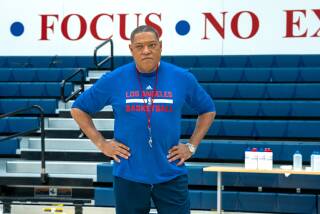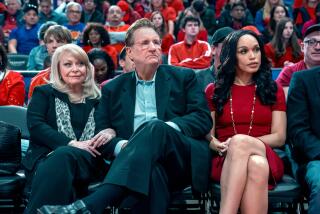Manning Gets Reflected Glory : He Plays Well When Clippers Are Obscure, Even Better When They Are in Spotlight
- Share via
Maybe it was only fair to someone who could do without the attention. Then again, maybe it was an injustice.
Whatever it was, the blossoming of Danny Manning occurred with relatively few people noticing. This, for a man who was watched intently for signs of stardom after he became the No. 1 pick in the 1988 draft, whose contract holdout and comeback from knee surgery were so heavily chronicled.
Stardom has occurred mainly over the last 24 games, since Larry Brown was hired by the Clippers, reuniting the coach and player who led Kansas to the 1988 NCAA championship.
Manning was averaging a team-high 17.5 points and shooting 51.8% when Brown signed on shortly before the All-Star break. Manning was already the most valuable Clipper of 1991-92, and he was 15 pounds lighter than last season--and showing it with defensive quickness and as one of the NBA’s best passing big men.
“When he first got (to the Clippers from college), the first 10 or 12 games he was active, but I haven’t seen it again until this year,” said Ed Manning, Danny’s father and an assistant coach with the San Antonio Spurs.
But the Clippers were 22-25 when Brown arrived.
“People somehow came to the conclusion I was having a bad year,” Manning said. “I wasn’t having a bad year, but it was a sub-par year for all of us as a team until Coach Brown came.
“It used to bother me. But then again, people probably weren’t paying attention to us earlier in the year, when we weren’t playing well for the most part.”
As the Clippers improved, the spotlight on Manning grew brighter.
He has responded well. After finishing 24th in the league in shooting last season, his first full campaign after the knee surgery, Manning is at 54.2%, eighth in the league. He has shot 59.9% in his last 19 games.
Manning had the advantage of familiarity with Brown and his motion offense. But any system that relied on constant ball movement would have set him up for what he loves most: capitalizing on mobility and ballhandling few his size can match.
It doesn’t have to translate into a lot of shots. During the 19-game run, he has had 15 or more shots only 10 times. He is averaging only 14.3 shots a game in March.
Those are not overwhelming numbers, but Manning’s is not an offensive style based on strength and dominance, even though he is 6 feet 10 and 232 pounds. Even his move from small forward to power forward since Brown’s arrival has not significantly altered his play.
How to best describe the Manning repertoire? He cuts through the lane for the occasional dunk but otherwise is off-speed: the jump-hook that often looks as if it was launched by a shotputter; the jump shot after a catch on the run; the under-and-up baseline leaner that features Manning sliding under the outstretched arms of a defender and then popping up for the shot.
Manning has been using most of those since high school, even though he probably could have dominated simply because of his size. But perhaps because he grew up playing against older boys, he has always been a finesse player. And now he plays with finesse in the pros.
Said Houston Coach Rudy Tomjanovich: “He makes the tough five- to 10-foot shot as well as anybody in the NBA.”
He leads the team in shooting, scoring and blocks, is second in minutes played, is tied for second in steals and is third in rebounds. He and Ron Harper are the only Clippers who have started all 71 games. And Manning’s 19.1-point average would be higher, were it not for one of the few weak spots in his game--a 72.1% accuracy rate from the free-throw line.
But what is most pleasing to those who have watched Manning, from family to Brown to the Clipper organization, won’t be found in numbers. That’s not how quickness is measured for someone coming off knee surgery that could have ruined a career.
Certainly, the weight loss has helped. Manning also says he hasn’t had any problems with the knee beyond tendinitis, a common malady. Ed Manning watches his son on TV or when the Clippers play the Spurs and sees an explosive tip dunk or lateral mobility that didn’t exist a year ago.
That leaves Brown, who denies that Manning is 100%, but finds much to be upbeat about.
“I don’t think it’s changed a heck of a lot,” Brown said in comparing the game of the former Manning to the current. “I think he’s more sure of himself, naturally. He was always a real bright player, but he’s even learned much, much more. I don’t think he’s as physically talented as he was in college, but I notice that coming back to him.
“He’s not as quick as he was before. I don’t think he jumps nearly as well. But I see improvement in that area. A lot of improvement. . . . When I saw him before, he was a shell of himself. He wasn’t able to run or jump or move nearly like he’s moving now.”
Manning describes the season as “pleasant.”
Pleasant?
“It’s been all right for me personally,” he said. “But we’re trying to get to the playoffs and win some games in the playoffs. Like any team in the league, we think we should have more wins.
“I should be shooting a higher free-throw percentage. A lot of things could be better. Granted, a lot of things are going in the right direction, but not to the point that I’m content.”
More to Read
Go beyond the scoreboard
Get the latest on L.A.'s teams in the daily Sports Report newsletter.
You may occasionally receive promotional content from the Los Angeles Times.






